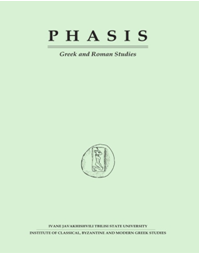Parodic Epiphany of Dionysus in T. S. Eliot’s Sweeney among the Nightingales
DOI:
https://doi.org/10.60131/phasis.17.2014.2333Abstract
Universalization of the specifically banal background in Sweeney among the Nightingales is provided by means of associative recollection of a variety of mythological plots. The associative structure of the poem is arranged in such a way that the process of eating at the restaurant (the ritual "nibbling" at the flesh of the killed God) occurs as a parodied act of Communion, associated with the murder and lechery taking place at the brothel: the victim should be killed in order to be eaten afterwards. Of course, no act of murder is being committed on the realistic or 'narrative' level of the poem – Rachel simply reaches for the grapes, yet on the level of symbolic associations, the Maenads 'with murderous paws' tear apart and devour the zoomorphic Dionysus. The moment of parodic Communion is emphasized here because, in fact, Rachel is consuming consecrated flesh and blood of the deity (according to Fraser, the participants of Dionysian revels believed that by eating the sacrificial flesh of the victim, they, like Dionysus, would also become gods). Following this pattern, the lady in the Spanish cape really sits on Sweeney’s lap and later on – sitting in a pool of coffee split on the floor, she "draws a stocking up." Yet, considering the whole set of symbolic associations, this extremely laconic obscenity is nothing more than a parodied "ritual adultery," committed while drinking wine (or drinking coffee in Eliot’s poem).Downloads
Published
2014-05-18
Issue
Section
Articles
License
Copyright (c) 2014 PHASIS

This work is licensed under a Creative Commons Attribution-NonCommercial 4.0 International License.


